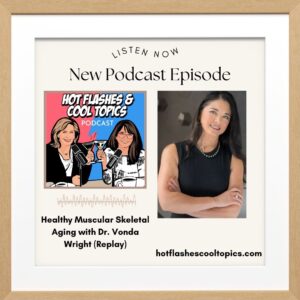
EPISODE LINK: DR VONDA WRIGHT
FOLLOW US ON:
Instagram: https://www.instagram.com/hotflashesandcooltopics/
Youtube:
Facebook:
EPISODE SUMMARY:
Replay Dr. Vonda Wright is a double-board certified orthopedic sports surgeon who has spent over 20 years researching and providing elite sports pros of all ages with the best strategies to help optimize their professional performances. In today’s episode, we sat down with Dr. Wright to discuss bone health in midlife, muscular and skeletal pain during menopause, how to overcome the fear of injury, and how often midlife women should be training to improve their muscles and bones.
First, we asked Dr. Wright about how our bone health changes in midlife. She told us that our bone health has more to do with how we care for our bones when we’re younger. Women have until their 30s to build healthy, sturdy bones. Maintaining strong bones is especially important for women with osteopenia and osteoporosis. Most women do not even know they have osteopenia until they break a bone, and for injuries such as hip fractures, the damage can be life changing. 50% of people with hip fractures do not return to pre-fall function, and 30% of elderly people with hip fractures die within the first year after the injury. However, there are practices that can be done at any age to help improve bone health. Some great ways to ensure we maintain healthy bones are jumping up and down 20 times a day and managing our nutrition by eating foods with vitamin D, vitamin C, magnesium, potassium, and protein. For osteopenia, it is important to be aware of symptoms and any family history of falls and height shrinkage. It is also important to get a Dexa scan to figure out your risk for osteopenia. If insurance will not cover it, the scan itself is $250.
Pain in muscles and bones during menopause is a common symptom, yet it is rarely ever brought up in menopausal discussions. 80% of women in perimenopause and menopause will have increased muscular and skeletal pain, and 20% of those women will have pain severe enough to impact their daily lives. All of your muscle and bone tissue have both alpha and beta receptors for estrogen, and when the estrogen in your body begins to decline, the cartilage becomes less structurally sound and can cause pain. Ways to improve the pain include building muscle mass, taking estrogen supplements, and incorporating bone health practices into your routine. For those with a previous history of injury, working out can be a daunting task. The fear of hurting yourself again can cause you to stay still and not try. But rather than give into the fear, Dr. Wright said it is important to figure out where the fear of mobility comes from and to work past it one step at a time. For example, if a person is afraid of jumping onto a 3-foot box, they should start with a smaller box and slowly work their way up to taller ones.
With jobs, children, marriages and more, midlife women do not always have the time for intense, long workouts. Rather than taking on everything at once, Dr. Wright encouraged midlife women to focus on lifting heavy weights to help build muscle mass. If there is any extra time, women should also try zone two aerobics, which are very low heart rate and the most efficient for metabolizing fat, for three hours a week in 45–60-minute sessions.
Finally, we asked Dr. Wright about the social stigmas towards aging and fitness. She explained that during the second world war, the life expectancy for people in the U.S. was 40, which contributed to the stereotypes surrounding midlife. However, current research shows that we can be healthy well into our later years. To do this, along with keeping a healthy and active lifestyle, we need to stop looking back at our younger years and pivot our mindset towards the future. We also spoke to Dr. Wright about the concept of renewing our DNA. She explained that while 70-80% of our health is determined by lifestyle choices, the other 30% is from our DNA. Through epigenetics, healthy lifestyle choices can have an impact on our DNA and improve our health.
Dr. Vonda Wright
Dr. Vonda Wright, double board-certified orthopedic sports surgeon and SPARTAN DOC harnesses the 20 years of research and caring of elite athletes, executives and high-performance people to provide actionable strategies for optimizing personal and professional performance from the backyard to the ball field to the boardroom via building physical and mental hardiness across the lifespan.
Dr. Wright cares for professional athletes of the NFL, PGA, World Rugby, the Pittsburgh & Atlanta ballet theaters as well as collegiate and elite masters competitors. She has written 5 books in the fitness and performance space which spurred a 20 sku fitness line in 500 Dick’s sporting goods stores, speaks worldwide for corporate, foundation & family office audiences and is a frequent national media authority contributor.
Currently, Dr. Wright serves as the inaugural President & Surgeon of the legacy Hughston Orthopedics Group- Southeast based in Lake Nona where she provides elite sports medicine to athletes and active people. An active aging and longevity researcher, she takes a whole person precision approach and offers individual HealthSpan and Longevity Advising and group retreats, The Precision Longevity Experience, to optimize performance and build precision strategic plans for lifetime health & aging.
Prior to moving to Orlando with her husband, 2x Stanley Cup Champion, Peter Taglianetti, Dr. Wright served as inaugural Medical Director of the 185 sq ft UPMC Lemieux Sports Complex and Chief of Sports Medicine & Orthopedics for the Northside health system in Atlanta.